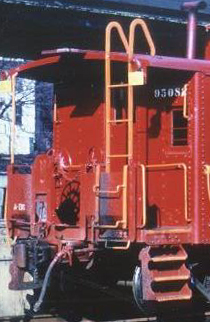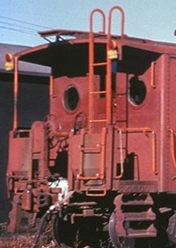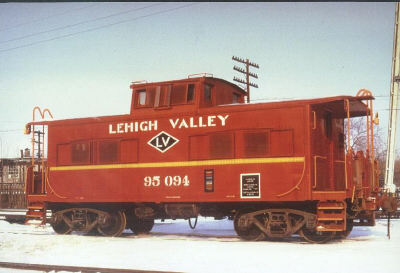
LV 95094, a typical late phase I caboose. Photographed by Charlie Houser, 1-12-74.
Lehigh Valley Northeast Style Steel Cabooses
The Lehigh Valley Railroad steel Northeast style cabooses were based on the Reading’s NMj design, but were modified to meet the needs of the LVRR. The first batch was built in 1937 by the Sayre shops, using components purchased from Bethlehem Steel. The tool box located beneath the floor on the Reading design was eliminated, a single rectangular end window was added, located at the extreme right of each end wall, and stronger end platform posts with kick panels attached were added to the design. Hand holds were also added to the tops of the end ladders, although the diamond tread roofwalk fitted flush with the roof remained as on the Reading caboose. The Duryea cushioned underframe of the Reading prototype was also retained on the LV cabooses until 1944, when several design changes were made, including dual circular end windows, a raised slotted roof walk and a change in the shape of the end ladder hand holds. That first batch of 20 cars when delivered in 1937 did not have the distinctive peaked rain gutters, wind deflectors and three tread steps that are now recognized as LV caboose signatures. These appeared on the second batch in 1939, and were later retrofitted to the first batch.
Over many years, other changes were made to cars in service as they were shopped. Sometime in the 1950s, a second rectangular window was added to the extreme left of the end walls on some cabooses. Doors were replaced over the service life of many cabooses, and the shape and number of window panes in the doors varies if you look closely at photos. Coal burning stoves were replaced by oil heaters on all mainline cabooses in the 1960s. These cars have taller stacks and a fuel filler located to the right of the rightmost side window near the heater. (Some cabooses received taller stacks prior to the decision to go to oil heat, so the stack height is not a reliable indicator that the coal stove was replaced.) Sometimes, the window next to the oil heater was blanked off. Still later, rock screens were added to many cabooses.
Phase Differences
As purchased these cabooses showed two basic phases, with several individual variations as listed below. Note that caboose numbers do NOT reflect the order in which they entered service! Check photographs of the car you want to build. These differences may or may not be important to you, depending on the amount of time you want to spend modeling them. I don’t plan to build all my cabooses to be absolutely correct, but I haven’t yet decided what, for me, is the right balance of accuracy vs building time and effort. Adding ladder end grabs and rain gutters is probably enough to capture the look of an LV caboose.
| Caboose number | Dates Entered Service | Distinguishing details |
| Phase I | ||
| 95050 – 95069 | 7/28/37 – 12/24/37 | Early Phase I: One rectangular end window set to extreme right. Diamond tread roof walks set flush with roof. Ladder side rails end at roof line, hand holds are round bar stock. Cast tender style steps with 3 treads. Cushion underframe. Birdsboro trucks. |
| 95070 – 95079 95080 – 95103 95001 – 95014 95015 – 95026 95027 – 95041 |
6/10/39 – 7/8/39 4/30/40 – 3/31/41 5/10/41 – 8/23/41 5/28/42 – 8/18/42 4/24/44 |
Late Phase I: Ladder hand holds are continuation of side rails. All other features were the same as early Phase I. |
| Phase I special cases | ||
| 95014, 95017, 95019, 95022-95026, 95059 | Fabricated steps with 3 treads. All other features were the same as the groupings in which these cars fit above, whether early or late Phase I. | |
| 95004, 95007, 95036-95038, 95050, 95055, 95056, 95059, 95064, 95065, 95073, 95075, 95077, 95084, 95090, 95092 | Second rectangular end window set to extreme left. All other features were the same as the groupings in which these cars fit above, whether early or late Phase I. | |
| 95051 | Solid underframe. All other features were the same as early Phase I. | |
| Phase II | ||
| 95042 – 95049 95104 – 95125 95126 – 95140 |
? – 6/30/45 7/24/45 – 11/30/45 3/29/46 – 5/31/46 |
Phase II: Two round (porthole) end windows. Raised slotted roof walks. Hand holds are integral with ladder side rails, but have different shape than Phase I. Cast tender style steps with 3 treads. Solid underframe. Gould trucks. |
Source: Dick Steinbrenner in Railroad Model Craftsman, August 1982: “Lehigh Valley Northeastern Caboose,” p. 55, and “The Ubiquitous Northeastern Caboose,” p. 78.
Spotting Features
|
Most Phase I cars have one rectangular (not square) window on the extreme right of each end, a roof walk that is flush with the roof surface, and angled ladder roof grabs. |
Phase II has two round “port hole” windows, a raised roof walk, and inverted U ladder roof grabs. |
|
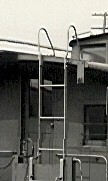 Early Phase I ladder rails end at roof line, and hand holds formed from round bar stock are attached to the ladder ends.Many surviving cabooses of all phases have had the hand holds cut off for safety reasons, but this happened after 4/1/76. Photos of these cars are not reliable guides, since they have usually been repainted, often incorrectly. Early Phase I ladder rails end at roof line, and hand holds formed from round bar stock are attached to the ladder ends.Many surviving cabooses of all phases have had the hand holds cut off for safety reasons, but this happened after 4/1/76. Photos of these cars are not reliable guides, since they have usually been repainted, often incorrectly. |
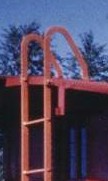 Late Phase I ladder has hand holds constructed as an extension of the ladder side rails, and appear thicker in side view, although general outline is the same as early Phase I. The rivets at the roof line attach to brackets on the roof edge, and do not hold the ladder rails to the grabs – they are one piece. Late Phase I ladder has hand holds constructed as an extension of the ladder side rails, and appear thicker in side view, although general outline is the same as early Phase I. The rivets at the roof line attach to brackets on the roof edge, and do not hold the ladder rails to the grabs – they are one piece. |
|
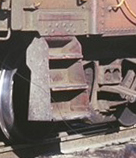 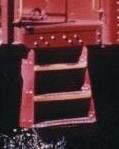 Fabricated steps, as found on SOME early Phase I cabooses. |
  Cast steps, used on all other LV cabooses, both Phase I and Phase II. |
|
Color Schemes
The Lehigh Valley Railroad was known for its many locomotive color schemes, and the story is no different with its cabooses. The following chart was put together from information posted to the Lehigh Valley Railroad Archives web site by Richard Jahn, and studies of published color photos by Lee Turner and myself. I’ve assigned numbers to the paint schemes, as Carl Steckler did for the diesel paint schemes, just to make it easier to reference them. These numbers were revised on 4/8/02 to reflect what appear to be the “official” paint schemes. Many variations existed in which parts of the new schemes were applied without completely repainting the car into the new scheme, but any list of these combinations would be lengthy, and ultimately incomplete!. The dates are the dates of published photos, NOT the date the caboose was painted into that scheme.
As with the diesel locomotives, faded and weathered colors are difficult to distinguish – dirty yellow safety stencils may look more like orange, unless there is a true orange stencil in the same photo to compare them to, and dirty white lettering tends to look yellow in some photos. Although ex-LVRR employees confirm that “freight car red” was the color used in early schemes, examination of photos containing both cabooses and Cornell Red locos shows that they sometimes weathered to a very similar shade! Others have claimed that “freight car red” was purchased from several paint suppliers, and varied considerably. Especially in later years, it looks like color variations within a paint scheme were common. Always short of cash, the Valley probably looked for the best buy in paint for its cabooses, and whether it was the exact same shade of red as the last paint purchase was not very important!
Fritz Kuenzel, current owner of 95026, reports that the original interior color was a beige or light tan, and that later repaints were at least two different shades of gray. At least one of the gray repaints may have been done by Conrail.
Comments, corrections and addtions are always welcome.
| Color Scheme | Photo Example | Known Cars & Photo References | Comments |
| #1 – Freight Car Red with white Roman lettering, white railings, hand grabs and step edges. Car number between windows, and “Route of the Black Diamond” slogan below the windows. | 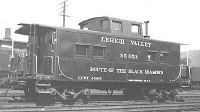 95053 as delivered, Jeffrey Jaynes, George Ellwood web site. |
95025: Greenberg & Fischer p.99 95050: Archer p.231 95053: Jaynes/Elwood 95065: Archer p.230 95103: Steam Era p.63 |
All delivered in this scheme, from the initial delivery in 1937. Discontinued in 1947, and mostly gone by 1949. |
| #2 – Freight Car Red with black bituminous roof coating, white Roman lettering without slogan, white railings, hand grabs and step edges.#2A – As above with yellow raiings, hand grabs and step edges.#2B – As #2A with yellow lettering and numbers. | 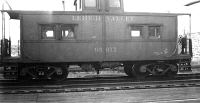 95011, Gary Overfield collection, George Ellwood web site. |
95011 (12/59): Overfield/Elwood 95114 (4/60): Bednar p.40 95140: Steam Era p.93 95xxx (5/52): LV3 p.28 95xxx (4/60): Bednar p.40 |
Standard scheme per LVRR paint diagram dated August 29, 1947. It is likely that all cabooses eventually received this scheme, since it lasted into 1960. Black did not extend to the edges of the roof, so often can not be seen in side views. Actual shades of red varied widely, some appearing to be the same Cornell Red used on locomotives, and others clearly a shade similar to that used on freight cars.At some point prior to the adoption of scheme #3, yellow was mandated as the color for railings and grabs, and some cars received that treatment without a complete repaint. It appears that during this period some cabooses also received yellow lettering, perhaps as a result of a misunderstanding of the directive on handrails and grabs. |
| #3 – Freight Car Red with black roof, white Roman lettering, yellow “Make Safety a Habit in 1960” stencil, yellow railings and grab irons. | 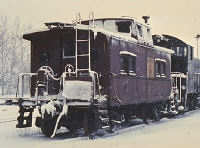 95119, Mark Nolan collection |
95030 (7/73): Bossler p.99 95033 (9/63): LV1 p.10 95034: RMC 8/82 p.82 95077 (4/63): LV1 p.13 95099 (Spring 66): Biery p.37 95100 (9/60): LV1 p.67 95100 (5/61): Sypher/Elwood 95130 (2/63): LV1 p.11 95119: at left 95xxx (9/65): LV1 p.11 |
Adopted January 1960. LVRR painting diagrams also show 1961 & 1962 versions, but there is no evidence that 1961 & 1962 were ever actually applied to a caboose. Examples lasted in this scheme as late as 1973! |
| #3A – Same as #3, but with no date in the safety stencil. |  95069, John Campell web site |
95004 (8/62): LV1 p.108 95013: Mark Nolan collection 95033 (4/72) 95039: RMC 8/82 p.79 95047 (7/64) 95069 (3/63): LV1 p.128 95099 (6/63): Bednar p.77 95099: Biery p.101 95109: Martin/Campbell 95132 (5/70): Bednar p.128 95xxx: LV3 p.80 |
“in 1960” dropped from the safety stencil. On early safety stencils, the date was painted over, leaving a blank area below the remaining wording. On later stencils, the wording is centered vertically. |
| #4 – Freight Car Red with white Gothic lettering, and white Roman numbers, orange “Make Safety a Habit” panel, orange railings and grab irons. | 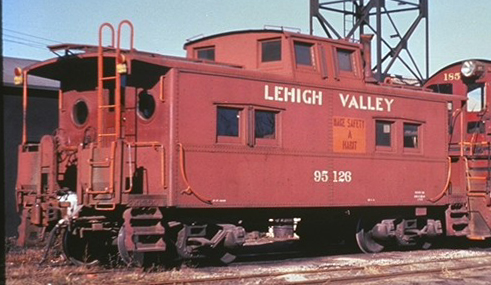 95126, Mark Nolan collection |
95005 (1963): RMC 8/82 p.79 95015 95017 (10/66): LV2 p.117 95026 (8/67): LV3 p.69 95031 (8/66): Bednar p.131 A95031* (6/73): Bossler p.100 95033 (4/72): LV1 p.118 95047 (7/64): Bednar p.89 95063 (4/72) 95064 (9/69): Martin/Campbell 95070 (7/72): Bednar p.86 95081: Bednar p.1 95083 (8/66): Bednar p.131 95109 (8/62): LV1 p.108 95126: Mark Nolan Collection 95128 (6/70): Bednar p.45 95132 (8/66): Bednar p.41 95134 (8/70): Bednar pp.65,68 95140 (10/69): Bossler p.99 951xx (9/63): LV1 p.10 95xxx (12/65): LV2 p.91 |
Adopted sometime in 1963-64.Many variations in which one component or another was not repainted from scheme 3. For example, 95132 & 95140 still carried white Roman style lettering with orange safety stencils and railings.Black roof coating was apparently phased out while this scheme was in use. Cars completely repainted had roof the same as the body color, while those that received new lettering and safety stencil may have retained the black roof coating. |
| #5 – Experimental “Snowbird” scheme – White with black gothic stencil lettering, red flag, black railings, ladders and grab irons, black on white “Make Safety a Habit” placard under leftmost window. | 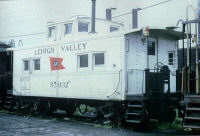 95032, Mark Nolan collection |
95032: Collection of Mark Nolan 95054: RMC 8/82 p.79 |
These were the only two cabooses ever to receive this paint scheme. Painting diagram dated 1/9/64. 95054 was repainted to scheme #7 by late 1969, but I don’t know how long 95032 carried this scheme before being repainted into #8. |
| #6 – Red with white gothic lettering, white Roman numbering, orange railings and grab irons. | 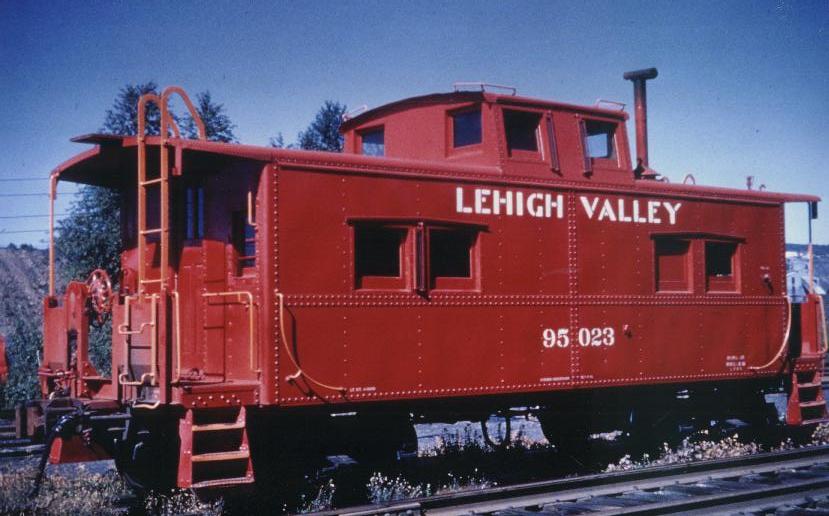 95023, Mark Nolan collection |
A95014 (8/74): Steubben/Elwood 95018 (5/69): Houser collection 95021 (6/73): LV2 p. 47 95021 (5/74): Bednar p.55 95023 (9/68): Houser/Nolan collection 95025 95028 with “A” overpainted (2/75) 95030 (8/74): Steubben/Elwood 95048: LV3 p.80 95048 (7/73): Bednar p.33 95066: Bossler p.100 95082 (2/71): LV1 p.100 95085 (6/67): Bednar p.132 95090 (3/72): Bednar p.108 95096 (8/72): ARHS LV Calendar 1999 95113 (1975): Bossler p.99 95xxx (11/72): LV1 p.62 95xxx (5/74): Bednar p.108 |
Use of this scheme can be documented over a period from 1967 to 1974. There were apparently many variations in the shade of red used, varying from Freight Car Red on early versions that were repainted from scheme 3 or 4, to what appear to be Cornell Red or Caboose Red on later cars that were completely repainted.Black roof coating may be seen on cars that were not completely repainted. In any case, the roof quickly accumulated a layer of black grime, so the modeler probably can’t go wrong by applying Grimy Black to the roof! |
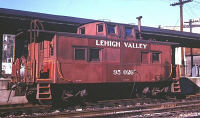 95026 by John Koehler, Mark Nolan collection |
Partial repaint into scheme #6 from #3, with Roman lettering replaced by gothic, and placard overpainted: 95026 (1/73): Koehler/Nolan collection 95050 (12/75): LV1 p.59 95056 (5/74): Bednar p.108 |
Note the difference in the faded portions of 95026 compared to the recently applied Freight Car Red, and the much brighter patch of “Caboose Red” under the end window. | |
| #7 – Tuscan Red with yellow numbers, lettering, belt stripe all around, and white flag. Yellow railings and grab irons. | 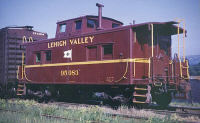 95083, John Campbell collection |
95010: RWJ 95035: RWJ 95054 (9/69): Martin/Campbell 95054(12/72): Bednar p.101 95054: Bossler p.101 95054: RMC 8/82 p.81 95083: Unknown/Campbell |
The LV painting diagram for this scheme is just an update of the white scheme with the colors changed and the yellow band added. Unfortunately, the date was not changed! Photo dates are few for this scheme, but we know that it existed as early as 1969. |
| #8 – PC Green with white gothic stencil letters & black diamond, orange railings and grab irons. | 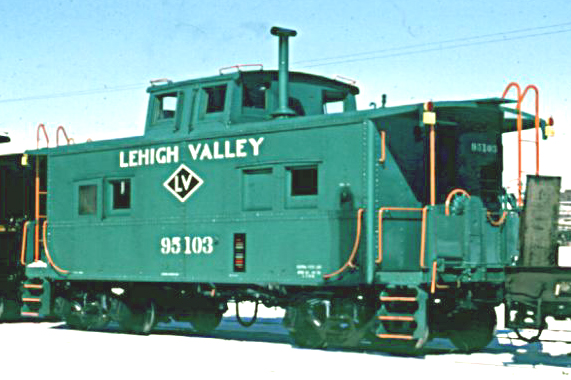 95103 by Wm Martin, John Campbell web site. |
95003: Bossler p.102 95015: RWJ 95016: RWJ 95020: RWJ 95027: RWJ 95032: RWJ 95035: Houser collection (Note: has white handrails, grabs & ladders) 95056: RWJ 95061: RWJ 95076 (w/o diamond): RWJ 95084: RMC 8/82 p.83; (11/72) Houser collection 95085: RWJ 95100: RWJ 95103: Martin/Campbell |
I have no information on the start date for this scheme, but it obviously was used after the adoption of the PC Green color by parent Penn Central. |
| #9 – Late Cornell Red with yellow stripe, white gothic stencil letters and black diamond, orange railings and grab irons. |  95094, Charlie Houser collection |
95002 (11/72): Bossler p.102 95016 (12/72): Bossler p.101 A95026 (2/75) 95030 (2/75): Steubben/Elwood 95046 95047 (12/73): Szachacz/Phillips/Elwood 95047: FD&S 2/1 p.23 A95054 A95062 (5/73): Bednar p.12 A95068 (3/76): Bednar p.127 95073 (2/73): Houser Collection 95077 (3/74): Louderback/Phillips/Elwood 95082 (2/73): Houser Collection A95088: Martin/Campbell A95089: Sypher/Elwood A95089 (10/73): Sypher/Elwood A95093: Martin/Campbell 95094 (1/74): Houser Collection 95094 (6/74): Bednar p.138 A95094 (10/75): LV3 p.128 95133 (2/74): Louderback/Phillips/Elwood 95133: Velez/Campbell 95133: RMC 8/82 p.78 |
This scheme can be photographically documented from late 1972. Whether the body color was actually Cornell Red can be debated, but that is the description used by Dick Steinbrenner, who photographed many of these cars, in his 8/82 RMC article. Allowing for color variations due to time of day, film considerations, etc., the body color on these cabooses seems to be relatively consistent. |
| #10 – Caboose Red (?) with white gothic stencil letters and black diamond, orange railings and grab irons. This is basically a simplified version of #9, omitting the yellow stripe. | 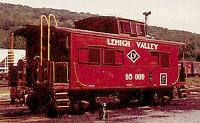 95009, Wm Martin, John Campbell web site. |
A95006 (12/73):Szachacz/Phillips/Elwood 95009: Martin/Campbell 95015 (4/75) A95033 (1/76): LV2 p.28 95036 (2/74): Louderback/Phillips/Elwood 95036 (2/74): Bossler p.100 95080: RMC 8/82 p.82 A95080: RMC 8/82 p.83 |
Earliest photographic documentation for this scheme is late 1974. Caboose red is again a debatable description, but many if not all of these cabooses seem to have a cooler body color than used in scheme 9, although there may be exceptions. |
| #11 – Bicentennial scheme: white & blue sides, red cupola and ends with white stars on ends of both body and cupola. | 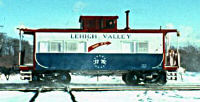 1776, Wm Martin, John Campbell web site. |
1776 (12/75): Bednar p.118 1776 (12/75): Archer p.299 1776 (12/75): Bossler p.98 1776 (1/76): LV2 p.28 1776 (2/76): Bossler p.98 1776: FD&S 2/1 p.23 1776: RMC 8/82 p.79 |
95085 was renumbered as 1776 in 12/75, and was the only caboose to receive this scheme. |
Notes:
1. In the early 1970’s, an “A” before the number on the side of the caboose indicated a caboose approved for main line and run-through service. All other cabooses were restricted to locals. Only cabooses with cushion underframes, upgraded trucks and oil heaters were eligible for this service, so phase II cabooses (porthole end windows, solid underframes) never had an A. As far as I know, the A did not appear on the end numbers.
2. 95054 appeared in two of the unusual schemes: snowbird and tuscan!
3. Photos of cabooses that may have been restored are not used as references, since there is no way of determining the authenticity of the restoration. Cabooses with the ladder grabs cut off (done by Conrail) all fall into this category.
4. Photos on other web sites are attributed Photographer/Webmaster, or Photographer/Submitter/Webmaster.
5. Photos on this web site are attributed Photographer/Submitter.
6. Caboose numbers without a photo reference but labeled RWJ come from a list supplied by Richard W Jahn, editor of Flags Diamonds & Statues, the publication of the Anthracite Railroads Historical Society.
